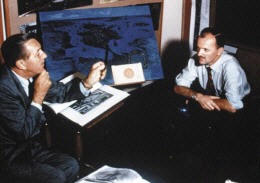 |
| Peter Ellenshaw |
One of the many elements that gave Walt Disney's live action film The Story of Robin Hood such a sumptuous quality were the matte effects of Peter Ellenshaw (1913-2007). We have looked at the life and work of Ellenshaw before on this blog and there are now over 10 pages on the subject here. But recently Neil has sent more examples of Ellenshaw's art work.
Below is an article that appeared in The Daily Mail describing the art of matte painting:
“Before computer-generated special effects, film-makers relied on ‘matte painting’ as a cheap substitute for building sets or filming on location. Matte paintings were made by artists using paints or pastels on large sheets of glass or integrating with the live-action footage via a double exposure.
Its foremost practitioner was Peter Ellenshaw (1913-2007), who joined Denham Studios in 1935 as an uncredited assistant to his stepfather, W. Percy Day, the inventor of matte painting on such things as Things To Come (1936) and The Thief Of Bagdad (1940).
In 1947, he created the wonderful mountain scenery for Michael Powell’s and Emeric Pressburger’s Black Narcissus. Martin Scorsese, a big fan, said that watching it was ‘like being bathed in colour.’”
***
After Black Narcissus, Ellenshaw worked on more than 30 films for Walt Disney Studios. He began working as a freelancer for Walt Disney in 1947 and became involved in the making of Treasure Island, the studios first live-action movie. It was the great art director Carmen Dillon that recommended Peter’s work to Walt Disney, for his next project in England, ‘The Story of Robin Hood and his Merrie Men’ in 1952.
 |
| Walt Disney and Peter Ellenshaw |
"Peter Ellenshaw is a clever young painter,” Carmen Dillon said, “and has the backing of his father-in-law, Poppa Day, who has been doing optical tricks and mattes with Korda for many years.” Walt Disney was interested and replied, “Good! We’ll paint all the long shots of medieval Nottingham, the castle, Richard going to the Crusades, etc. on glass. They’ll be much more fun than the real thing.”
On Robin Hood, Peter Ellenshaw eventually painted 52 matte shots. A technique that impressed the film’s producer Ken Annakin so much, that in his next picture for Disney, The Sword and The Rose, he used 64 of Ellenshaw’s fine matte work.
So began Peter’s long career with the Disney Studios and a 30 year friendship with Walt Disney himself, of whom he regarded as a wonderful inspiration. Ellenshaw was officially designated a 'Disney Legend' in 1993.
Neil says:
"Just attaching these that you may have seen – I certainly haven’t – from The Story of Robin Hood and His Merrie Men 1952.
Some Matte Shots – before and after – that were so good I had never imagined that they were mattes at all. I am sure you will agree.
This is staggering work to me – and so impressive.
Trouble is it spoils things in a way because I always thought that the shots of Robins escape at the river scene was all a real location that I have even been to look for."
 |
| The pond becomes a river |
I agree with Neil, some of the scenes I thought were 'real' locations, were in fact created by Ellenshaw. Above is a fine example. The first image is possibly one of the ponds used by Alex Bryce's second unit at Burnham Beeches. In the next shot is the same spot transformed by Peter Ellenshaw's matte magic.
 |
| Robin reaches a different riverbank |
Above is another scene from Robin Hood's escape from the sheriff. This time we see the outlaw crossing the river on horseback. In the second image Ellenshaw has added a much steeper and more tree-lined bank.
 |
| Nottingham town square |
In Neil's third example of Peter Ellenshaw's work (above), we are in Nottingham town square. This is the moment King Richard's ransom money is jubilantly carried off to the castle. The scene has been filmed on one of the giant sound stages in Denham Studios. But the matte process transports outside into the sunlight.
 |
| Construction of the final scene |
The last series of images show the construction of the final scene of the movie. Top right is just the ground shot in which Alan a Dale walks. Around that image Peter Ellenshaw has painted trees and a beautiful sunset. And it is in this evocative closing scene the minstrel strolls off into history spreading the legend of Robin Hood.
A very big thank you to Neil Vessey for sharing these fascinating images with us. Don't forget to visit Neil's own website Films of The Fifites.
A very big thank you to Neil Vessey for sharing these fascinating images with us. Don't forget to visit Neil's own website Films of The Fifites.




























